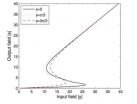(Press-News.org) PHILADELPHIA (June 19, 2014) – We already know haters are predisposed to be that way. Now we see they also spend a lot of time at fewer activities than their non-hater counterparts.
But in a twist of irony, that grumpy person at work may actually be pretty good at their job since they spend so much time on fewer activities, thereby giving them the opportunity to hone their skills in specific tasks.
It's all covered in a new study published in the journal Social Psychology. It seems that a person's "dispositional attitude" – whether the person is a "hater" or a "liker" – plays an important role in his or her activity level.
The article, "Liking more means doing more: Dispositional attitudes predict patterns of general action," is written by Justin Hepler, Department of Psychology, University of Illinois at Urbana-Champaign; and Dolores Albarracín, Annenberg School for Communication and Department of Psychology, University of Pennsylvania. Assuming that our disposition motivates behavior, Hepler and Albarracin suggested that people who like many things (those with positive dispositional attitudes) also do many things during the course of a week, while people who dislike many things (those with low dispositional attitudes) do very few things with their time.
They were right. In two studies, participants reported all of their activities over a one-week period and also completed a measure of dispositional attitudes. Although haters (someone with a low dispositional attitude) and likers (someone with a high dispositional attitude) did not differ in the types of activities they pursued, haters tended to do fewer activities throughout the week than did likers. Nearly 15 percent of the differences in how many activities people conducted during a typical week was associated with being a hater versus a liker.
Haters and likers also did not differ in how much time they spent doing activities throughout the week; they merely differed in the number of activities that they did. As a result, haters spent more time on any given activity than did likers. Thus, compared with likers, haters could be characterized as less active because they do fewer things, or they could be characterized as more focused because they spend more time on the small number of things they do.
"The present results demonstrate that patterns of general action may occur for reasons other than the desire to be active versus inactive," the researchers wrote. "Indeed, some people may be more active than others not because they want to be active per se, but because they identify a large number of specific behaviors in which they want to engage."
Hepler and Albarracín suggest that their findings may have implications for understanding the development of skills and expertise. For example, likers may adopt a jack-of-all-trades approach to life, investing small amounts of time in a wide variety of activities. This would leave them somewhat skilled at many tasks. In contrast, when haters find an activity they actually like, they may invest a larger amount of time in that task, allowing them to develop a higher skill level compared to likers. They said future work should confirm this possibility.
This same pattern could also be relevant to attentional control. For example, likers may have more difficulty sustaining attention on a task because they perceive so many interesting and distracting opportunities in their environment. In contrast, because haters like so few things, they may be unlikely to be distracted when they are doing a task, and thus their generalized dislike may actually benefit their attentional control.
INFORMATION:
Haters spend more time…hating?
U. Illinois/Penn study sheds light on activity levels based on one's attitude disposition
2014-06-19
ELSE PRESS RELEASES FROM THIS DATE:
Criminal profiling technique targets killer diseases
2014-06-19
A mathematical tool used by the Metropolitan Police and FBI has been adapted by researchers at Queen Mary University of London to help control outbreaks of malaria, and has the potential to target other infectious diseases.
In cases of serial crime such as murder or rape, police typically have too many suspects to consider, for example, the Yorkshire Ripper investigation in the UK generated a total of 268,000 names. To help prioritise these investigations, police forces around the world use a technique called geographic profiling, which uses the spatial locations of ...
Humans have been changing Chinese environment for 3,000 years
2014-06-19
For thousands of years, Mother Nature has taken the blame for tremendous human suffering caused by massive flooding along the Yellow River, long known in China as the "River of Sorrow" and "Scourge of the Sons of Han."
Now, new research from Washington University in St. Louis links the river's increasingly deadly floods to a widespread pattern of human-caused environmental degradation and related flood-mitigation efforts that began changing the river's natural flow nearly 3,000 years ago.
"Human intervention in the Chinese environment is relatively massive, remarkably ...
Study: Controllable optical steady behavior obtainable from nonradiation coherence
2014-06-19
A new proposed scheme, by Wen-Xing Yang, from the Department of Physics, Southeast University, China, and colleagues, analyzed in detail the optical steady behavior in GaAs quantum well structure driven by an elliptically polarized field (EPF) in a unidirectional ring cavity.
They show that the controllable optical steady behavior including multi-stability (OM) and optical bistability (OB) can be obtained via nonradiation coherence, and the frequency detuning, cooperation parameter and the amplitude of the EPF. Most interestingly, the conversion between OB and OM can ...
Iconic Minnesota conifers may give way to a more broad-leafed forest in the next century
2014-06-19
Houghton, Mich., June 19, 2014: Over the next 100 years, Minnesota's iconic boreal forest and deep snow may change into a deciduous forest with winters warm enough for some precipitation to fall as rain, according to a new U.S. Forest Service assessment of the vulnerability of Minnesota forests to climate change.
"Minnesota Forest Ecosystem Vulnerability Assessment and Synthesis" was published by the U.S. Forest Service's Northern Research Station and is available online at: http://www.nrs.fs.fed.us/pubs/45939
The assessment describes effects of climate change that ...
The sweetest calculator in the world
2014-06-19
Jena (Germany) In a chemistry lab at the Friedrich Schiller University Jena (Germany): Prof. Dr. Alexander Schiller works at a rectangular plastic board with 384 small wells. The chemist carefully pipets some drops of sugar solution into a row of the tiny reaction vessels. As soon as the fluid has mixed with the contents of the vessels, fluorescence starts in some of the wells. What the Junior Professor for Photonic Materials does here – with his own hands – could also be called in a very simplified way, the 'sweetest computer in the world'. The reason: the sugar molecules ...
Cochrane Review -- Effectiveness of antimicrobial drugs to treat cholera
2014-06-19
Researchers from the Cochrane Infectious Diseases Group, co-ordinated through the editorial base in LSTM, conducted an independent review of the effects of treating cholera with antimicrobial drugs, published in The Cochrane Library today.
Cholera is an acute watery diarrhoea caused by infection with the bacterium Vibrio cholerae, which can cause rapid dehydration and death. Effective treatment requires early diagnosis and rehydration using oral rehydration salts or intravenous fluids. This review looked at the effects of adding antimicrobial drugs to this treatment.
Thirty-nine ...
Synaptic levels of clathrin protein are important for neuronal plasticity
2014-06-19
Researchers of the group of cellular and molecular neurobiology of the Bellvitge Biomedical Research Institute (IDIBELL) and the University of Barcelona, led by researcher Artur Llobet, have shown that synaptic levels of the protein clathrin are a determinant factor for synaptic plasticity of neurons.
Chemical synapses and synaptic vesicular transmission cycle
Neurons transmit information in a specialized contact points called synapses. These structures consist of two elements: the presynaptic one, information donor, and postsynaptic, which receives the information. In ...
Children consuming a Mediterranean diet are 15 percent less likely to be overweight
2014-06-19
A study of 8 European countries presented at this year's European Congress on Obesity (ECO)in Sofia, Bulgaria, shows that children consuming a diet more in line with the rules of the Mediterranean one are 15% less likely to be overweight or obese than those children who do not.
The research is by Dr Gianluca Tognon, University of Gothenburg, Gothenburg, Sweden, and colleagues across the 8 countries: Sweden, Germany, Spain, Italy, Cyprus, Belgium, Estonia and Hungary.
The researchers used data from the IDEFICS study (Identification and Prevention of Dietary – and lifestyle ...
Recreational football reduces high blood pressure in mature women
2014-06-19
The World Cup in Brazil may be attracting a global armchair audience of millions, but new research has shown that playing football could help lower blood pressure in women aged 35-50.
Women within this age group with mild high blood pressure achieve a significant reduction in blood pressure and body fat percentage through playing recreational football for 15 weeks. This is the finding of a new study conducted in a collaboration between researchers across four countries, including Professor Peter Krustrup of the University of Exeter.
The acclaimed Scandinavian Journal ...
MA healthcare reform does not have early impact on disparities in cardiovascular care
2014-06-19
New research by the Brigham and Women's Hospital, in partnership with Howard University College of Medicine, explores the effect of healthcare reform in Massachusetts on coronary intervention and mortality in adults by race/ethnicity, gender and the level of education in the neighborhood where the patient resides.
Published in the June 17, 2014, issue of Circulation, the journal of the American Heart Association, these findings indicate that healthcare reform in Massachusetts has not yet impacted the likelihood of receiving coronary interventions by gender, race/ethnicity ...
LAST 30 PRESS RELEASES:
Making lighter work of calculating fluid and heat flow
Normalizing blood sugar can halve heart attack risk
Lowering blood sugar cuts heart attack risk in people with prediabetes
Study links genetic variants to risk of blinding eye disease in premature infants
Non-opioid ‘pain sponge’ therapy halts cartilage degeneration and relieves chronic pain
AI can pick up cultural values by mimicking how kids learn
China’s ecological redlines offer fast track to 30 x 30 global conservation goal
Invisible indoor threats: emerging household contaminants and their growing risks to human health
Adding antibody treatment to chemo boosts outcomes for children with rare cancer
Germline pathogenic variants among women without a history of breast cancer
Tanning beds triple melanoma risk, potentially causing broad DNA damage
Unique bond identified as key to viral infection speed
Indoor tanning makes youthful skin much older on a genetic level
Mouse model sheds new light on the causes and potential solutions to human GI problems linked to muscular dystrophy
The Journal of Nuclear Medicine ahead-of-print tip sheet: December 12, 2025
Smarter tools for peering into the microscopic world
Applications open for funding to conduct research in the Kinsey Institute archives
Global measure underestimates the severity of food insecurity
Child survivors of critical illness are missing out on timely follow up care
Risk-based vs annual breast cancer screening / the WISDOM randomized clinical trial
University of Toronto launches Electric Vehicle Innovation Ontario to accelerate advanced EV technologies and build Canada’s innovation advantage
Early relapse predicts poor outcomes in aggressive blood cancer
American College of Lifestyle Medicine applauds two CMS models aligned with lifestyle medicine practice and reimbursement
Clinical trial finds cannabis use not a barrier to quitting nicotine vaping
Supplemental nutrition assistance program policies and food insecurity
Switching immune cells to “night mode” could limit damage after a heart attack, study suggests
URI-based Global RIghts Project report spotlights continued troubling trends in worldwide inhumane treatment
Neutrophils are less aggressive at night, explaining why nighttime heart attacks cause less damage than daytime events
Menopausal hormone therapy may not pose breast cancer risk for women with BRCA mutations
Mobile health tool may improve quality of life for adolescent and young adult breast cancer survivors
[Press-News.org] Haters spend more time…hating?U. Illinois/Penn study sheds light on activity levels based on one's attitude disposition





